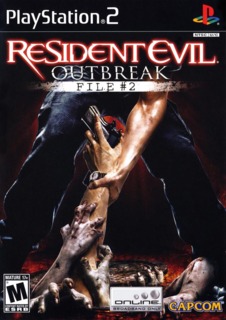very good game i
--------------------------------------------------------------------------------------------
Resident Evil: Outbreak: File #2, known in Japan as Biohazard Outbreak: File 2 (バイオハザード アウトブレイク FILE2?), is an online survival horror game developed and published by Capcom. It was released for the PlayStation 2 in Japan on September 9, 2004, North America on April 26, 2005, and Europe on August 26, 2005.
Following the success of Outbreak in Japan, Capcom announced the release of the sequel Resident Evil: Outbreak: File #2 in fall of 2004. The same eight characters from the first title return with similar abilities, and the game once again takes place in a zombie-inhabited Raccoon City. Five new scenarios are available, and the first four are available from the beginning. In Japan the game was packaged with a demo of Devil May Cry 3 if pre-ordered.
The player chooses a scenario, difficulty level and a character. The difficulty level is tied to what enemies and items the player encounters as they progress through the scenario. The game has five scenarios, each of which has an event checklist consisting of special actions that the player must perform to reach 100% completion. Upon doing so the player will unlock "Infinity Mode" in which all the player's weapons never break or run out of ammunition.
Each scenario also has "SP" items. These are invisible items hidden throughout the level, and are randomly generated on two paths. There are twenty scenario items for each scenario, and twenty items specific to each character hidden across the five scenarios. If acquired, these items unlock new costumes and the option to listen to their ad-libs.
Scenario 1: Wild Things
Scenario 2: Underbelly
Scenario 3: Flashback
Scenario 4: Desperate Time
Scenario 5: End of the road
[edit] Controls
The ad-lib driven communication system used in Outbreak was retained and improved on. Rather than using USB headphones or a computer keyboard, players use a command "ad-lib" system which consists of ten key command phrases, used with the right joystick on the PlayStation controller, and a button which selected lines depending on the situation (e.g. Announce the status of the player). The player can select items from their teammate's inventory and request it, or ask them to use it. The new additions included the ad-lib phrase "Sorry", and the ability to say comments based on what players were looking at on the Map and File screens.
The sequel also boasted a new difficulty feature and some changes to the game's balance. These include a new "Nightmare Mode" and several alterations to previous damage charts.
[edit] Regional differences
In the American version of the game, the 'ad-libs' from the first game have been removed. Subsequently only when a character uses the analog stick or makes a request do they make a noise. If context ad-libbing is attempted no sounds are made, negatively affecting gameplay. If a player attempts to tell another that they are poisoned the chances the message will be noticed are low if they are in the middle of combat. The Japanese release features full voices, while the European features only voices and no text.
The Japanese version features Japanese subtitles for the cutscenes while all characters speak English, like previous Biohazard games. Because of the character variety, this leads to a strange continuation where the Japanese subtitles read as having all characters saying the same thing in some situations.
Linda is called Rinda in the Japanese version. In the Japanese language, the L and R are interchangeable.
In Japan the game ran on the KDDI MMBB service. In America, this service was swapped out for the Sega Network Application Package. Because of this change, several features were removed from the NTSC/PAL versions, including private messaging, advance search options, and special options to limit the rankings to find specific ranks.
[edit] Multiplayer mode
On March 31, 2007, Capcom closed their PAL and US servers for File #2.[1].
Online Play was given a major overhaul from that of the previous game. File #2 had a new lobby system, new event system, and an increase in options and modes of play.
Capcom ran events from April to late May 2005 that were sponsored by various gaming magazines. This included events from PSM and EGM, amongst others. Clearing these events rewarded the players with characters and costumes. Some events took place in standard levels on set difficulties, while others placed the player in selected levels with Infinite and Nightmare options activated, before the two options were available for free use. After all sponsored events ended, Capcom ran two events in circulation, a point bonus event, and an SP item hunt.
The lobby system was revamped to include ten areas with different options in each one, however this change made it harder to join games with friends. In order for a player to join a friend in their hosted or current game the player needed to enter a menu to search for their name, then exit that menu, choose the area they are in, and find the game. This menu did not mention the amount of players in the game when searched for, meaning a game could be full before the player joined.
In early July Capcom closed an alternate server, leaving only one choice for the player when they connected. Months after, Nightmare Mode, Infinite Mode, and changes to the Area system were made. HDD Support was dropped from the Area Screen, but players could still host games with HDD mode turned on by activating it offline.
From within the game, or by a link on the official Capcom sales page of their US site, players could look and see their position on the ranking boards.

